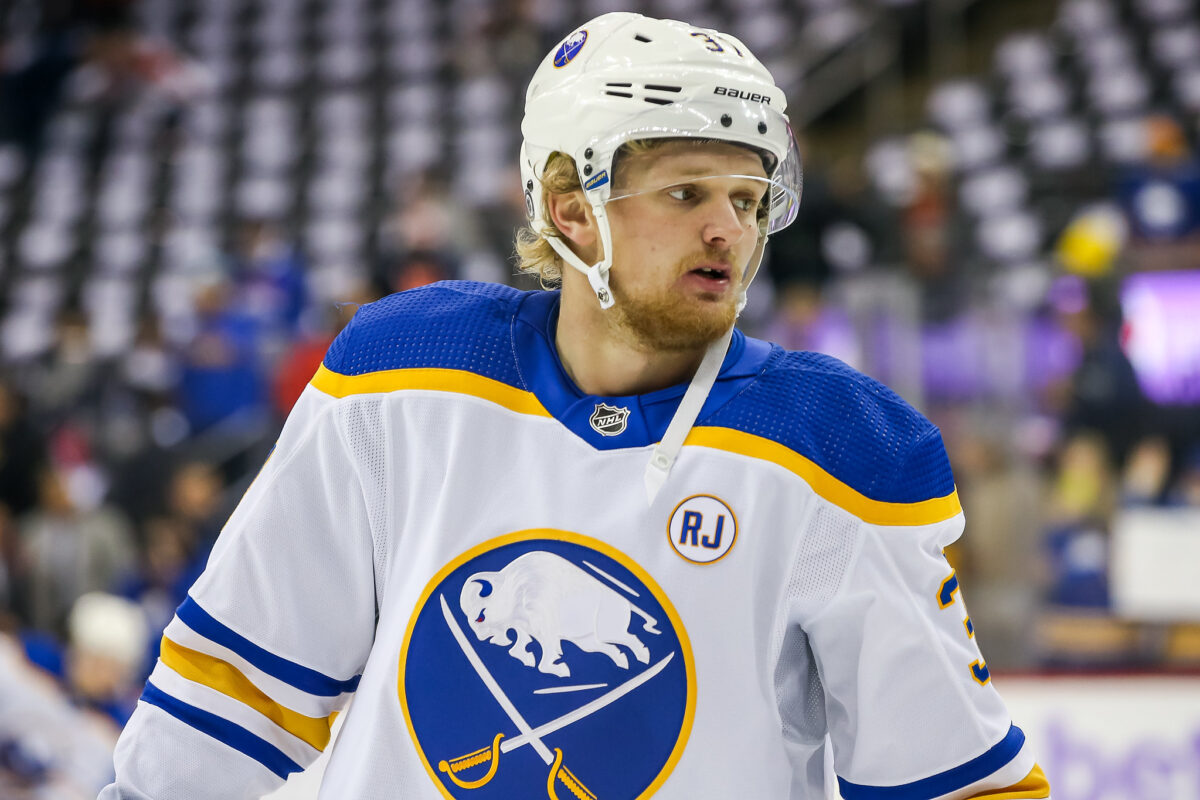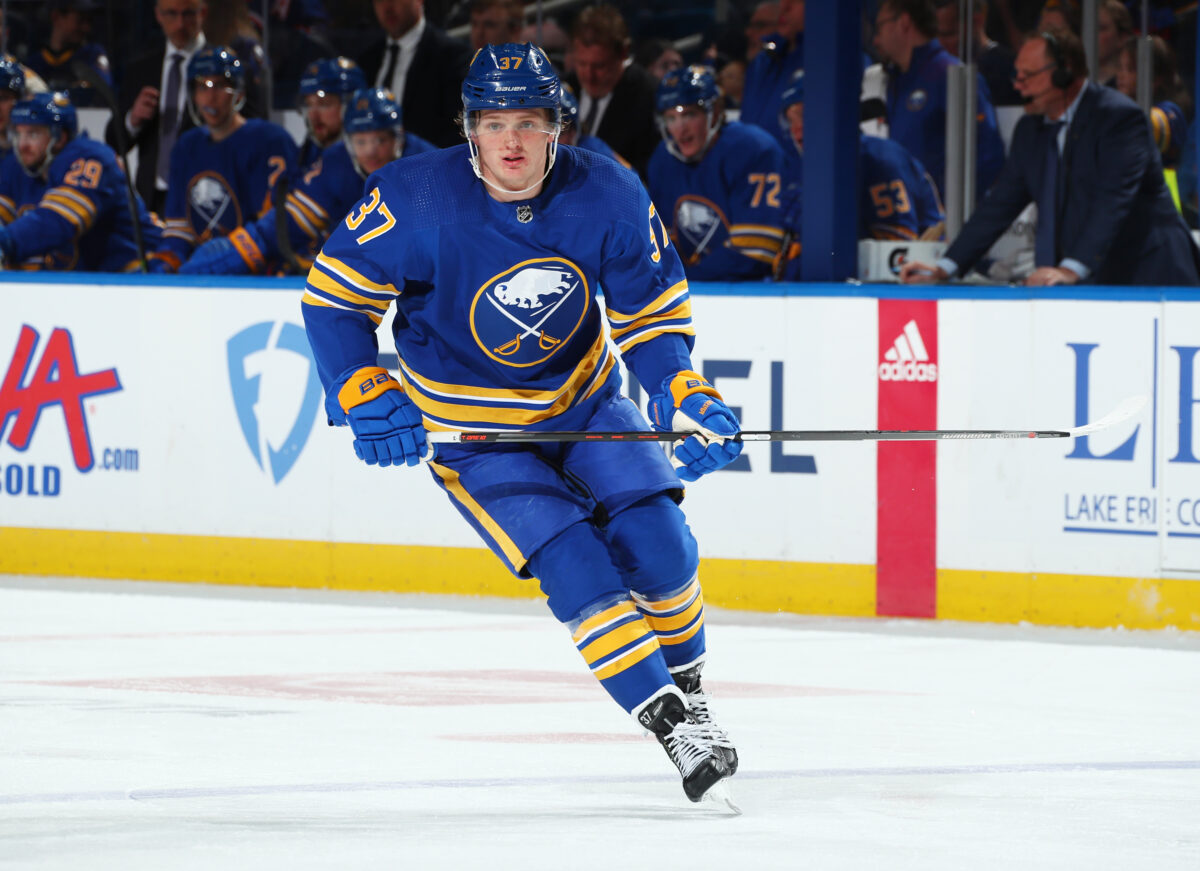For much of the season, Buffalo Sabres’ center Casey Mittelstadt has been among their best players. His play has struggled of late, resulting in his dropping down to a third-line center role, but for the first 30 or so games, he played like the dominant player we saw at the end of last season. As it stands, he is one of three players (Owen Power and JJ Peterka) to play in all 42 games, and he leads the team in assists (24), points (35), and for those who value the statistic, plus/minus (plus-9). He plays the second most per-game of any Sabres forward and is a presence on the team’s first power-play unit.
Mittelstadt’s underlying statistics too are strong, placing fifth among regulars in expected goals share (xGF%) with 52.17% and 10th in expected goals for per-60 minutes (xGF/60). His defensive work has fallen off over the last quarter of the season, but he was among the leaders for expected goals against per 60 minutes (xGA/60) for the first quarter.
All this is to say that Mittelstadt has earned a substantial raise from his three-year, $2.5 million average annual value (AAV) bridge deal that he signed in September 2021. When he signed the contract, he had never surpassed 25 points in a single season; since then, he’s posted a 59-point campaign in 2022-23 and is on pace to score 66 points this season. His establishment as a top-six caliber player on a team that’s struggled to score this year is well worthy of a shiny new extension.
The Bridge Path
One route the Sabres could opt to take is offering Mittelstadt another bridge deal. While not the ideal move in my opinion, they could look at a bridge deal for one of two reasons: 1) they believe that these past two seasons are outliers and his play on the ice is indicative of point-scoring regression, or 2) they believe in Mittelstadt but don’t want to pay him the money for a long-term extension right now. Of the two, the second option is the more likely — doling out almost $20 million per year to defensive stars Rasmus Dahlin and Owen Power do leave the Sabres with less cap space to play with than you’d think.

To figure out comparables for Mittelstadt, it’s important to include not just his statistical profile, but playstyle as well. As a pass-first player, he uses his speed, high hockey sense, and top-notch competitiveness to create space for his teammates. His brain and awareness of his teammates and opposition are easily his best attributes. There are a few players who immediately come to mind who have similar career trajectories and playstyles while also netting bridge deals at this stage in their careers: Dylan Strome, Pavel Zacha, and Andre Burakovsky.
Strome is a pass-first, brainy player with good size, though his skating ability doesn’t hold a candle to Mittlestadt’s. Zacha too is heady and pass-first, but he relies a bit more on his stature to create plays than just brainpower. Burakovsky is likely the most similar of the three, with speed, decent size, good hands, and a knack for drawing defenders out of position to give space to his teammates.
Strome signed a two-year bridge deal with the Chicago Blackhawks with an AAV of $3 million in 2020 before signing another bridge deal with the Washington Capitals in 2022 — this time for one year at $3.5 million. Zacha had two bridge deals with the New Jersey Devils, with the first being three years at $2.25 million and the second being one year at $3.5 million. Burakovsky signed three bridge deals; his first, with the Capitals, was two years at $3 million per. His second and third, both with the Colorado Avalanche, were one year at $3.25 million, and two years at $4.9 million.
Related: Sabres’ Star Players Need to Have More Impact
Mittelstadt’s production has been less consistent than those three throughout his career, but the ceiling that he’s shown is noticeably higher. As such, if the Sabres were to sign him to a bridge deal, my estimate would be two or three years at $4 million AAV.
Signing Mittelstadt Long-Term
What the Sabres should do is sign Mittelstadt to a long-term, five-to-eight-year contract to get him locked up as part of the core for the foreseeable future. Adding pieces to your long-term core, so long as they’re productive players with high ceilings, is never a bad idea. Mittelstadt certainly fits that bill.

Much like there were with the bridge deal options, there are a few prime examples of players who are similar in caliber to Mittelstadt and have received long-term extensions with their respective squads: Nick Schmaltz, Jonathan Drouin, and William Karlsson. Schmaltz is very similar in terms of production, career outlook, and trajectory, while both of Drouin and Karlson — Karlsson especially — have stronger defensive games than Mittelstadt does. All three players signed their long-term extensions with their teams directly off of their entry-level contracts, with Schmaltz signing for seven years at $5.95 million AAV, Drouin for six years at $5.5 million, and Karlsson signing a max-length, eight-year deal at $5.9 million.
With this in mind, should the Sabres decide to opt for a long-term extension, which is probably the right move, I would say that they’d be looking at a six-year deal for $5.75 million annually. He is 25 years old, so a six-year deal gives them the option to refrain from re-signing him if he ages poorly.
Sabres Should Extend Him To a Long Deal
Mittelstadt has undoubtedly earned a healthy raise for his next contract, be it a bridge deal or long-term. As it stands, I would prefer the latter of the two — long-term deals to younger, freshly broken-out players tend to pay off as they improve over time (Jack Hughes, Tage Thompson, and Elias Pettersson to name a few), whereas bridge deals sometimes end up being disastrous if the player performs incredibly well and earns a higher pay-grade than what they would have if teams had just signed them long-term from the get-go. If he signs a bridge deal and continues playing at this level, his next contract — which will be long-term — will be a behemoth that the Sabres can easily avoid by giving him a lengthy deal now.
